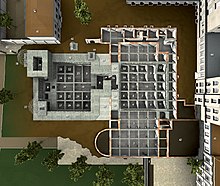Erich Kempka
Erich Kempka (born September 16, 1910 in Oberhausen ; † January 24, 1975 in Freiberg am Neckar ) was an SS member and Hitler's driver from 1932 to 1945 .
Youth and education
Kempka was born the son of a miner. The family had a total of ten children. He attended elementary school and then began an apprenticeship as an electrical engineer, which he completed in 1928. He then worked as a mechanic at DKW until March 31, 1930 .
Career in the time of National Socialism
On April 1, 1930, Kempka joined both the NSDAP (membership number 225.639) and the SS (2.803) and was initially employed as a driver for the NSDAP district in Essen . On February 29, 1932, he switched to Hitler's SS escort command and was appointed second driver for the Führer on behalf of Julius Schreck . After Schreck's death in 1936, he became Hitler's permanent driver and ran his fleet of vehicles, which over time grew to 40 vehicles and 60 drivers and mechanics (as of 1945). In 1943 he was together with Otto G possibly best man of Hans-Hermann Junge and his wife Traudl Junge . Kempka was at the end of the rank of Obersturmbannführer .
In October 1944, Kempka divorced his wife under pressure from Hitler and Bormann . She was accused of having worked in the "half-silk trade" before her marriage. Due to character traits and her loose mouth, she had also fallen out of favor in Hitler's inner circle. The divorce was arranged by Bormann, as can be read in Martin Bormann's letters to his wife. Kempka rented her an apartment on Kurfürstendamm and stayed in touch with her. He himself lived in a building on the premises of the Reich Chancellery , in the immediate vicinity of which the garages and workshops for the vehicle fleet were located. The building was near the entrance to the Führerbunker .
Employed directly in Hitler's vicinity, Kempka was present or even involved in many historical events of the time, such as the arrest of Ernst Röhm . In April 1945 he was one of those responsible for the cremation of the bodies of Hitler and Eva Braun. He had the order to get 200 liters of gasoline for this, but could only organize 160 to 180 liters. To do this, his employees had to drain the petrol from vehicles that had already been damaged by combat and were unfit to drive.
After the war
In the battle for Berlin , Kempka managed to break out of the capital and make his way to Berchtesgaden , where he was arrested by the US Army on June 18 or 20, 1945 . Interned in various camps until October 1947, he then lived in Munich and later in Freiberg am Neckar. In his memoirs and in the Nuremberg Trials , he testified to having seen Martin Bormann injured and probably killed by a German tank that exploded after being shot at. Today, this presumption can be proven beyond doubt as refuted, since in 1972 the bodies of Bormann and Ludwig Stumpfegger were found during earthworks by the Deutsche Bundespost in Invalidenstrasse near the Lehrter Stadtbahnhof . The find proved the testimony of the Reich Youth Leader Artur Axmann and his adjutant Günter Weltzin , who claimed to have seen the bodies of the two after their attempt to escape. “In January 1954 a court in Berchtesgaden pronounced him dead and set the date of death as May 2, 1945 at midnight. The death is registered under the number 29223 in a Berlin registry office. ”A DNA analysis in 1998 proved Bormann's death.
memoirs
In 1950 Kempka's memoirs were first published by Kyrburg Verlag in Munich under the title I burned Adolf Hitler . In this book he describes in simple words his career over the thirteen years as Hitler's driver to his experiences in the last few days in the bunker. He describes in detail the burning of the Hitler couple in the early afternoon on April 30, 1945.
From the 1970s to the 1990s, the work experienced several new editions under the changed title The Last Days with Adolf Hitler in the NPD- affiliated "Deutsche Verlagsgesellschaft". The editing of the originally brief description of the experience by the right-wing extremist journalist Erich Kern caused the book to swell from originally around 100 pages to 324 pages (3rd edition, 1991). Kern added numerous chapters that have no intrinsic connection with the original memoir. Kempka was not the author of around two thirds of the book, although the work is distributed under his authorship.
media
In the film Der Bunker (1981) Erich Kempka is portrayed by the actor Robert Grange and in Der Untergang (2004) by Jürgen Tonkel .
literature
- Christa Schroeder : He was my boss. 4th edition, Herbig, Munich 1985, ISBN 3-7766-2286-5 , note no.148.
- Hugh Trevor-Roper : The Bormann Letters. Weidenfeld and Nicholson, London 1954, ISBN 0-404-16908-2 .
- Erich Kempka: The last few days with Adolf Hitler. 4th edition, DGV , Rosenheim 1994, ISBN 3-920722-07-8 .
- James P. O'Donnell, Uwe Bahnsen : The catacomb - the end in the Reich Chancellery. Deutsche Verlagsanstalt, Stuttgart 1975, ISBN 3-421-01712-3 . English edition: James P. O'Donnell: The Bunker. The History of the Reich Chancellery Group. Houghton Mifflin, Boston 1978, ISBN 978-0-395-25719-7 .
Individual evidence
- ↑ Jochen von Lang: The Secretary: Martin Bormann: The man who ruled Hitler. S. Fischer Verlag 2019, ISBN 3-105-6224-03 .
- ↑ DER SPIEGEL of May 4, 1998: Bormann's skeleton clearly identified
| personal data | |
|---|---|
| SURNAME | Kempka, Erich |
| BRIEF DESCRIPTION | German SS member, driver of Adolf Hitler |
| DATE OF BIRTH | September 16, 1910 |
| PLACE OF BIRTH | Oberhausen |
| DATE OF DEATH | January 24, 1975 |
| Place of death | Freiberg am Neckar |


